Advertisement
Commentary
The swastikas in my neighborhood

It's hard to ignore: Hate and antisemitism have been in the news a lot lately. Former President Donald Trump is dining with white supremacists; high profile professional athletes are pushing antisemitic tropes; the artist formerly known as Kanye West tweeted a swastika inside of a Star of David last week. And according to the Anti-Defamation League, 2022 is likely to continue the troubling trend charted in 2021, which was the “highest year on record” for documented reports of harassment, vandalism and violence against Jews.
Elon Musk opted to act against West last week, suspending him from Twitter. I’m glad for that, though I would have preferred that Musk acknowledge the correlation between calling himself “a free speech absolutist” and the sharp increase in hate speech on Twitter since he took over. (Even better: He would actually acknowledge the sharp increase in hate speech on Twitter.)
Or perhaps what I really wish for Musk is the same thing that I wish for my high school students every time one of them anonymously scribbles a swastika or slur on a bathroom wall — that he spend less time mistaking permissiveness for freedom, and more time compassionately considering the deep and personal impact of hate speech.
I grew up as one of only a few Jews in a small, sleepy town on the coast of Maine. But I never really felt threatened, only out of place. At worst, teachers would schedule quizzes on Rosh Hashana every year and shop clerks would remind you of your otherness with their relentless Christmas cheer.
I never even encountered a swastika until I was 19 years old, while wandering the alleyways of Kathmandu with a Tibetan friend. We’d been discussing the similarities between Judaism and Buddhism when I noticed a giant swastika, painted oddly upright on a wall. I stopped and stared, desperately trying to figure out how to register what I was seeing.
It’s not what you think, my friend told me. Before it was appropriated, it was an auspicious sign that signified prosperity.
And yet even as I understood that this image was meant to symbolize good fortune, I couldn’t stop staring, paralyzed by the strange and sobering emotions it was triggering inside of me.
On the wall in Kathmandu, the symbol almost looked like two graceful dancers in the middle of the tango or pieces of a crossword puzzle — so different from the two swastikas I discovered at the playground down the street from my house.
I was monkeying around on the one of the play structures when I found them etched on the top of the slide with a knife.
My 8-year-old had been rollerblading with my wife on the basketball court while I was busy chasing my younger daughter around the playground. I was monkeying around on the one of the play structures when I found them etched on the top of the slide with a knife. My younger daughter flew right past them and waited for me at the bottom. But I paused where I was, again struggling to register what I was seeing.
If we’d encountered these in a different town, it might have simply felt disconcerting, a sign of the political times — but this was the playground that I’d been taking my kids to since they were babies. In a progressive town with a sizable Jewish community.
I had no intention of pointing them out to my kids, but when my 8-year-old overheard me speaking to my wife in hushed tones, she became alarmed and kept asking what we were talking about. And I knew that if I didn’t show them to her, her imagination would lead her to far worse places.
I lost much of my family during the Holocaust. But it was such a deeply personal, sensitive and secretive story in my household growing up that I’ve often struggled to imagine how I would ever talk about it with my daughters. They had such unadulterated pride in being Jewish, such faith in the goodness of this world.
As my older daughter and I climbed the stairs to the slide, I worried that things were about to come crashing down.
What do they mean? she asked, when I pointed them out to her.
They’re just a symbol, I said, that some people write to make other people feel bad.
Like for their religion? she asked.
Yeah, I said. Like for their religion.
She looked at them, then up at me, then said, Okay, and slid down the slide so she could run back to the basketball court to draw with chalk.
I knew that neo-Nazis were not taking over my neighborhood; I didn’t think white supremacists were hanging out on our local playgrounds. Intellectually, I realized they were probably etched by some 12-year-old without any understanding of its history or impact.
But it still felt so deeply unsettling to see those tiny swastikas and how they looked just like the ones you see in old books — like swirling tornadoes or a tangling of limbs, one body tumbling forward while the other stumbles backwards, a tilting of history and off-kilter intersection of fates.
Editor's note: A version of this essay will appear in Berman's forthcoming essay collection, "Writing While Parenting" (March 2023, Able Muse Press).
